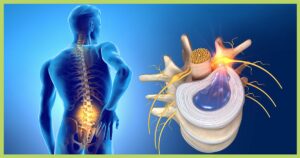What’s Really Going on With a Herniated Disc?
A herniated disc happens when one of the soft, cushion-like discs between the bones in your spine (called vertebrae) bulges or slips out of place. This can press on nearby nerves and cause pain, numbness, or weakness—especially in your arms or legs.
Many people with a herniated disc can recall a moment—like lifting something heavy or twisting—that triggered their pain. Unlike typical muscle strain, the pain from a herniated disc often feels sharp, burning, or like it’s shooting down your leg (sciatica). In serious cases, it can also lead to weakness or loss of feeling.
Despite how painful it sounds, many herniated discs get better on their own with rest and care. Some people may not even realize they have one because they don’t feel any symptoms.
What Causes a Herniated Disc?
Discs are made of a tough outer layer and a soft, jelly-like center. A disc herniates when the inner part pushes out through a tear in the outer layer. The main reasons this happens include:
- Aging: As we get older, the discs dry out and become weaker.
- Injury: Lifting, twisting, or trauma can cause a disc to slip.
- Other Conditions: Some people are born with spine shapes or tissue disorders that make them more prone to herniation.
Herniated discs most often occur in the lower back (lumbar spine) and neck (cervical spine) because these areas move the most. They’re less common in the mid-back (thoracic spine).
What’s Happening Inside the Body?
The bulging disc can press directly on nerves in the spine, which causes pain. It also releases chemicals that trigger inflammation, making the pain worse. The most common type of herniation happens just to the side of the spine, where nerves exit. If the disc bulges straight back, it can press on the spinal cord and cause more serious issues.
How Do I Know If I Have One?
You might notice:
Understanding Herniated Disc Symptoms
- A sharp, burning, or electric-like pain
- Pain that shoots down your leg or arm
- Numbness or tingling
- Weakness or unsteadiness
- Difficulty walking or lifting things
Many people remember exactly when it started—often after lifting, bending, or twisting.
How Common Is It?
Herniated discs affect about 5 to 20 out of every 1,000 adults each year. [1] They’re most common between the ages of 30 and 50 and occur about twice as often in men as in women. Only about 1% to 3% of people with lower back pain have a herniated disc as the cause.
Where Do They Happen?
- Neck (Cervical Spine): The most common problem area is between the C6 and C7 bones.
- Mid-Back (Thoracic Spine): Less common, but if it happens, it’s usually in the lower thoracic spine (T8-T12).
- Lower Back (Lumbar Spine): This is the most common site, with symptoms like pain, tingling, or weakness in the legs.
Diagnosis & Evaluation
Most herniated disc symptoms go away within 8 to 12 weeks with basic care. But if someone has nerve problems or their pain isn’t improving, doctors may recommend imaging (like an MRI) to get a better look. [2]
How Do You Fix it?
Non-Surgical (Conservative) Care:
Most people start with:
- Anti-inflammatory medications
- Physical therapy
- Activity modification
These treatments usually help reduce pain and improve movement. If symptoms don’t improve or if there’s nerve damage, surgery may be needed.
Surgery:
Surgery is typically a last resort. Common procedures include:
- Discectomy: Removing part of the disc
- Laminectomy: Relieving pressure on the spinal cord or nerves
While surgery can bring quicker relief, studies show that long-term outcomes are often similar to non-surgical care after a year. [3]
What’s the Outlook?
Most people recover well without surgery. In fact, many herniated discs heal on their own. About 90% of people feel better within 6 weeks with conservative care. Surgery is helpful in select cases and can speed up recovery. [3]
Are There Any Risks?
If not treated properly, a herniated disc can sometimes lead to:
- Chronic back pain
- Nerve damage (in rare cases)
- Need for additional surgery if symptoms return
Complications from surgery are rare but can include nerve injury or, in extreme cases, paralysis or death—though these are very uncommon.
Quick Summary
- A herniated disc in the upper and mid-back (thoracic spine) can press on nearby nerves or the spinal cord. Depending on what it presses on, it may cause nerve pain or affect the spinal cord itself.
- People often describe a burning pain, numbness, tingling, changes in sensation, or even weakness in the arms or legs.
- Most cases get better with simple treatments and don’t require surgery.
- For herniated discs in the neck (cervical spine) or lower back (lumbar spine), the first step is usually conservative care—this means over-the-counter pain meds, stretching and movement exercises, heat or ice, and staying as active as is comfortable.
- How long recovery takes depends on how bad the injury is and what caused it. Most people feel significantly better within 2 to 12 weeks.
- Since most people improve within 6 weeks, doctors typically wait before ordering an MRI—unless symptoms are severe, like constant numbness, weakness, or trouble with wlaking or coordination.
- If symptoms don’t improve or get worse over time, additional treatments like steroid injections or other pain-relief procedures may be considered.
- Surgery is rarely needed.
Reference
- Fjeld OR, Grøvle L, Helgeland J, Småstuen MC, Solberg TK, Zwart JA, Grotle M. Complications, reoperations, readmissions, and length of hospital stay in 34 639 surgical cases of lumbar disc herniation. Bone Joint J. 2019 Apr;101-B(4):470-477.
- Carlson BB, Albert TJ. Lumbar disc herniation: what has the Spine Patient Outcomes Research Trial taught us? Int Orthop. 2019 Apr;43(4):853-859.
- Schoenfeld AJ, Weiner BK. Treatment of lumbar disc herniation: Evidence-based practice. Int J Gen Med. 2010 Jul 21;3:209-14.


